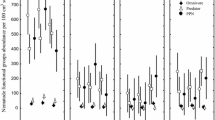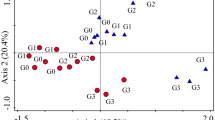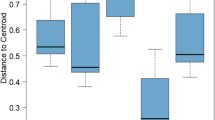Abstract
The influence of soil matric potential on nematode community composition and grazing associations were examined. Undisturbed cores (5 cm diameter, 10 cm depth) were collected in an old field dominated by perennial grasses on a Hinckley sandy loam at Peckham Farm near Kingston, Rhode Island. Ten pairs of cores were incubated at −3, −10, −20 and −50 kPa matric potential after saturation for 21–28 or 42–58 days. Nematodes were extracted using Cobb's decanting and sieving method followed by sucrose centrifugal-flotation and identified to family or genus. Collembola and enchytraeids present were also enumerated because they are grazers that reside in air-filled spaces. Direct counts of bacteria and fungi were made to estimate biovolume using fluorescein isothiocyanate and fluorescein diacetate stains, respectively. Trophic diversity and maturity indices were calculated for nematode communities. Three patterns of matric potential effect were observed for nematode taxa. One, there was a consistent effect of matric potential for all seasons for Alaimus, Monhysteridae, Prismatolaimus, Paraxonchium and Dorylaimoides. Two, some effects of matric potential were consistent among seasons and other effects were inconsistent for Aphelenchoides, Aphelenchus, Cephalobidae, Coomansus, Eudorylaimus, Huntaphelenchoides, Panagrolaimidae, Paraphelenchus, Sectonema, and Tripyla. Third, effects of matric potential were always inconsistent among seasons for Aphanolaimus, Aporcelaimellus, Bunonema, Rhabditidae, and Tylencholaimus. As predicted, fungal and bacterial biomass responded oppositely to matric potential. Total bacterial biomass was greater at −3 kPa than −10, −20 and −50 kPa (P=0.0095). Total fungal biomass was greater at −50, −20 and −10 kPa than −3 kPa (P=0.0095). Neither bacterial-feeding, fungal-feeding nor predacious nematodes correlated significantly with bacterial or fungal biomass. Omnivorous and predacious nematodes correlated positively with number of bacterial-feeding nematodes; predacious nematodes also correlated positively with fungal-feeding nematodes. Numbers of Collembola and enchytraeids were more often correlated positively with microbial-grazing nematode numbers in drier than moist soils. From this study, we propose two mechanisms that may explain nematode community structure changes with matric potential: differential anhydrobiosis and/or enclosure hypotheses. The later suggests that drying of soil generates pockets of moisture in aggregates that become isolated from one another enclosing nematodes and their food in relatively high concentrations creating patches of activity separated by larger areas of inactivity.
Similar content being viewed by others
References
Anderson JM 1988 Invertebrate-mediated transport processes in soils. Agric. Ecosyst. Environ. 24, 5-19.
Anderson ARA, Young IM., Sleeman BD, Young IM and Grifiths BS 1997 Nematode movement along a chemical gradient in structurally heterogeneous environment. 2. Theory. Fund. Appl. Nematol. 20, 165-172.
Andrássy I 1968 The genera and species of the family Tylenchidae Oerley, 1880 (Nematoda). The genus Malenchus Andrássy. Acta. Zool. Hung. 27, 1-47.
Andrássy I 1979 The genera and species of the family Tylenchidae Oerley, 1880 (Nematoda). The genus Tylenchus Bastian, 1865. Acta Zool. Hung. 25, 1-33.
Andrássy I 1980 The genera and species of the family Tylenchidae Oerley, 1880 (Nematoda). The genus Aglenchus (Andrássy, 1954) Meyl, 1961, Miculenchus Andrassy, 1959, and Polenchus gen.n. Acta Zool Hung. 26, 1-20.
Andrássy I 1984 The genera and species of the family Tylenchidae Oerley, 1880 (Nematoda). The genera Cephalen-chus (Goodey,1962) Golden, 1971 and Allotylenchus gen.n. Acta. Zool. Hung. 30, 1-28.
Aroian RV, Carta L, Kaloshian I and Sternberg PW 1993 A free-living Panagrolaimus sp from Armenia can survive in anhydro-biosis for 8.7 years. J Nematol. 25, 500-502.
Ayoub SM 1980 Plant Nematology, an Agricultural Training Aid. NemaAid Publications, Sacramento, CA, 195 pp.
Babiuk LA and Paul EA 1970 The use of fluorescein isothiocyanate in the determination of the bacterial biomass of a grassland soil. Can. J. Microbiol. 16, 57-62.
Beare MH 1997 Fungal and bacterial pathways of organic matter decomposition and nitrogen mineralization in arable soils. In Soil Ecology in Sustainable Agricultural Systems. Eds L Brussaard and R Ferrera-Cerrato. pp. 37-70. Lewis Publishers, Boca Raton, FL.
Beare MH, Parmelee RW, Hendrix PF and Cheng W 1992 Micro-bial and faunal interactions and effects on litter nitrogen and decomposition in agroecosystems. Ecol. Monogr. 62, 569-591.
Beare MH, Coleman DC, Crossley DA Jr, Hendrix PF and Odum EP 1995 A hierarchical approach to evaluating the significance of soil biodiversity to biogeochemical cycling. Plant Soil 170, 5-22.
Bongers T 1987 De nematoden van Nederland. Bibliotheek van de KNNV, no. 46. Pirola, Schoorl, Netherlands. 408 pp.
Bongers T 1990 The maturity index: an ecological measure of envir-onmental disturbance based on nematode species composition. Oecologia 83, 14-19.
Bongers T, deGoede RGM, Korthals GW and Yeates GW 1995 Proposed changes of c-p classification for nematodes. Russian J. Nematol. 3, 61-62.
Caveness FE and Jensen HJ 1955 Modification of the centrifugal-flotation technique for the isolation and concentration of nemat-odes and their eggs from soil and plant tissue. Proc. Helminthol. Soc. 22, 87-89.
Darbyshire JF 1976 Effect of water suctions on the growth in soil of the ciliate Colpoda steini, and the bacterium Azotobacter chroococcum. J. Soil Sci. 27, 369-376.
Demeure Y, Freckman DW and van Gundy SM 1979 Anhydrobiotic coiling of nematodes in soil. J. Nematol. 11, 189-195.
Elliott ET, Anderson RV, Coleman DC and Cole CV 1980 Habitable pore space and microbial trophic interactions. Oikos 35, 327-335.
Ettema CH 1998 Soil nematode diversity: species coexistence and ecosystem function. J. Nematol. 30, 159-169.
Freckman DW and Caswell EP 1985 The ecology of nematodes in agroecosystems. Annu. Rev. Phytopathol. 23, 275-296.
Freckman DW, Kaplan DT and van Gundy SD 1977 A compar-ison of techniques for extraction and study of anhydrobiotic nematodes from dry soils. J. Nematol. 9, 176-181.
Goodey JB 1963 Soil and Freshwater Nematodes. John Wiley, New York. 544 pp.
Griffin DM 1969 Soil water in the ecology of fungi. Annu. Rev. Phytopathol. 7, 289-310.
Griffiths BS 1994 Soil nutrient flow. In Soil Protozoa. Ed. J F Darbyshire. pp. 65-91. CAB International, London.
Griffiths BS, Young IM and Caul S 1995 Nematode and protozoan population-dynamics on decomposing barley leaves incubated at different soil matric potentials. Pedobiologia 39, 454-461.
Hassink J, Bouwman LA, Zwart KB and Brussaard L 1993 Relation-ships between habitable pore space, soil biota and mineralization rates in grassland soils. Soil Biol. Biochem. 25, 47-55.
Hendrix PF, Crossley DA Jr, Blair JM and Coleman DC 1990 Soil biota as components of sustainable agroecosystems. In Sus-tainable Agricultural Systems. Eds CA Edwards, L Rattan, P Madden, RH Miller and G House. pp. 637-654. Soil and Water Conservation Society, Ankeny.
Hunt DJ 1993 Aphelenchida, Longidoridae and Trichodoridae: Their Systematics and Bionomics. CAB International, Walling-ford. 352 pp.
Ingham ER and Klein DA 1984 Soil fungi: relationships between hyphal activity and staining with fluorescein diacetate. Soil Biol. Biochem. 16, 273-278.
Jones FGW and Thomasson AJ 1976 Bulk density as an indicator of pore space in soils usable by nematodes. Nematologica 22, 133-137.
Kastner A and Germershausen K 1989 Composition and abund-ance dynamics of the nematode fauna in a Chernozem loess soil. Hercynia N.F. 26, 71-93.
Killham K 1994 Soil Ecology. Cambridge University Press, New York. 242 pp.
Killham K, Amato M and Ladd JN 1993 Effect of substrate location in soil and soil pore-water regime on carbon turnover. Soil Biol. Biochem. 25, 57-62.
Lodge DJ and Ingham ER 1991 A comparison of agar film tech-niques for estimating fungal biovolumes in litter and soil. Agric. Ecosyst. Environ. 34, 131-144.
Maggenti AR 1983 Nematode higher classification as influenced by species and family concepts. In Concepts in Nematode Systemat-ics. Eds AR Stone, HM Platt and LF Khalil. pp. 25-40. Academic Press, New York.
Maggenti AR 1991 Nematoda: higher classification. In Manual of Agricultural Nematology. Ed. WR Nickle. pp. 147-187. Marcel Dekker, New York.
Maggenti AR, Luc M, Raski DJ, Fortuner R and Geraert E 1987 A reappraisal of Tylenchina (Nemata). 2. Classification of the suborder Tylenchina (Nemata: Diplogasteria). Rev. Nematol. 10, 127-134.
May RM 1981 Theoretical Ecology: Principles and Applications. Sinauer Associates, Oxford. 489 pp.
Moore JC, de Ruiter PC, Hunt HW, Coleman DC and Freckman DW 1996 Microcosms and soil ecology: critical linkages between field studies and modelling food webs. Ecology 77, 694-705.
Neher DA and Campbell CL 1994 Nematode communities and mi-crobial biomass in soils with annual and perennial crops. Appl. Soil Ecol. 1, 17-28.
Nicholas WL 1998 Mesorhabditis kinchegensis sp.nov.(Nematoda: Rhabditidae) from arid soil in Kinchega National Park. Trans. R. Soc. South Aust. 122, 79-84.
Nickle WR 1991 Manual of Agricultural Nematology. Marcel Dekker, New York. 1035 pp.
Parmelee RW, Bohlen PJ and Edwards CA 1995 Analysis of nem-atode trophic structure in agroecosystems: Functional groups versus high resolution taxonomy. In The Significance and Regu-lation of Soil Biodiversity Eds HP Collins, GP Robertson and MJ Klug. pp. 203-207. Kluwer Academic Publishers, Dordrecht.
Popovici I 1984 Nematode abundance, biomass and production in a beech forest ecosystem. Pedobiologia 26, 205-219.
Proctor DLC 1990 Global overview of the functional roles of soil-living nematodes in terrestrial communities and ecosystems. J. Nematol. 22, 1-7.
Quénéhervé P and Chotte J-L 1996 Distribution of nematodes in vertisol aggregates under a permanent pasture in Martinique. Appl. Soil Ecol. 4, 193-200.
SAS Institute 1990 SAS/STAT User's Guide, Version 6, 4th Edn, Volumes 1 and 2. SAS Institute, Inc., Cary, NC. 1848 pp.
Shannon CE and Weaver W 1949 The Mathematical Theory of Communication. University of Illinois, Urbana, IL.
Söhlenius B 1980 Abundance, biomass and contribution to energy flow by soil nematodes in terrestrial ecosystems. Oikos 34, 186-194.
Thorne G 1961 Principles of Nematology. McGraw-Hill, New York.
Tobar A, Valor H and Talavera M 1995 Kinetics of recovery from anhydrobiosis in Pratylenchus thornei, Merlinius brevidens and Heterodera avenae from dryfield soils and dry roots of the host-plant. Fund. Appl. Nematol. 18, 21-24.
Walker BH 1992 Biodiversity and ecological redundancy. Conserv. Biol. 6, 18-23.
Wallace HR 1958 Movement of eelworms. I. The influence of pore size and moisture content of the soil on the migration of larvae of the beet eelworm, Heterodera schachterii Schmidt. Ann. Appl. Biol. 46, 74-85.
Wardle DA and Yeates GW 1993 The dual importance of competi-tion and predation as regulatory forces in terrestrial ecosystems: evidence from decomposer food-webs. Oecologia 93, 303-306.
Wardle DA, Yeates GW and Watson RN 1995 The detritus food-web and the diversity of soil fauna as indicators of disturbance regimes in agro-ecosystems. Plant Soil 170, 35-43.
Wasilewska L 1979 The structure and function of soil nematode communities in natural ecosystems and agrocoenoses. Pol. Ecol. Stud. 5, 97-145.
Wharton DA 1996 Water loss and morphological changes during desiccation of the anhydrobiotic nematode Ditylenchus dipsaci. J. Exp. Biol. 199, 1085-1093.
Wharton DA and Barclay S 1993 Anhydrobiosis in the free-living Antarctic nematode Panagrolaimus davidi (Nematoda, Rhab-ditida). Fund. Appl. Nematol. 16, 17-22.
Wong PTW and Griffin DM 1976a. Bacterial movement at high mat-ric potentials. I. In artificial and natural soils. Soil Biol. Biochem. 8, 215-218.
Wong PTW and Griffin DM 1976b Bacterial movement at high matric potentials. II. In fungal colonies. Soil Biol. Biochem. 8, 219-223.
Yeates GW, Wardle DA and Watson RN 1993a Relation-ships between nematodes, soil microbial biomass and weed-management strategies in maize and asparagus cropping systems. Soil Biol. Biochem. 25, 869-876.
Yeates GW Bongers T, de Goede RGM, Freckman DW and Geor-gieva SS. 1993b Feeding habits in soil nematode families and genera: an outline for soil ecologists. J. Nematol. 25, 315-331.
Author information
Authors and Affiliations
Rights and permissions
About this article
Cite this article
Neher, D.A., Weicht, T.R., Savin, M. et al. Grazing in a porous environment. 2. Nematode community structure. Plant and Soil 212, 85–99 (1999). https://doi.org/10.1023/A:1004665120360
Issue Date:
DOI: https://doi.org/10.1023/A:1004665120360




